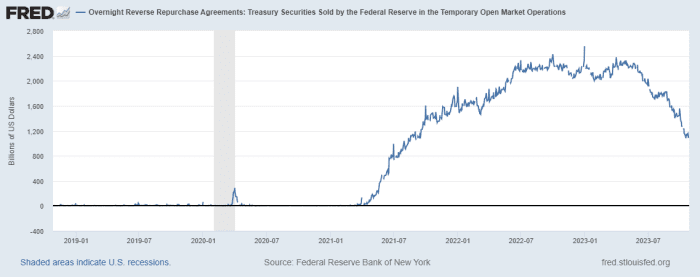A Federal Reserve repo facility is back in focus as a gauge of liquidity as U.S. stocks stumble and investors brace for another barrage of Treasury borrowing to fund the U.S. government’s large budget deficit.
Funds parked by institutional investors short-term at the New York Fed’s overnight reverse repo facility have dropped to $ 1.1 trillion from a peak of about $ 2.5 trillion in December, according to Fed data.

Cash park at the Fed’s overnight facility has been falling on heavy Treasury supply to fund the government’s large borrowing needs.
Federal Reserve
It signals that a major source of cash waiting on the sidelines to deploy to buy Treasury debt or other cash-like investments over the past two years has dramatically dwindled.
The retreat also comes as the S&P 500 index SPX was on pace to log a close in correction territory Friday, with any finish below 4,130.06 marking a slump of at least 10% from its recent closing high of 4,588.96 set on July, according to FactSet. The Nasdaq Composite Index COMP logged its 70th correction earlier this week.
While funds parked overnight at the Fed have been earning 5.3%, recently, the volume of cash has decreased sharply since the Treasury began stepping up debt issuance to fund a large federal budget deficit. For fiscal year 2023 it was pegged at $ 1.7 trillion, up 23%, from a year ago.
“I’ve been tracking the volume and size of the Fed reverse repo facility,” said Bryce Doty, a senior portfolio manager at Sit Investment Association in Minneapolis. “It isn’t a perfect measure of liquidity,” he said, but worth watching as the Treasury prepares next week to announce its coming borrowing needs.
Read: Wall Street braces for roughly $ 1.5 trillion in further borrowing needs by Treasury
The Fed also is widely expected on Wednesday to hold its policy interest rate steady at a 22-year high in the 5.25%-5.5% range.
Doty said the roughly $ 1 trillion cash pile in the Fed’s repo facility was still a huge amount. “But what happens if that gets tapped out?”
U.S. stocks and bonds have been volatile in the second half of this year as the Fed bolstered its message that interest rates likely need to stay higher for longer to keep falling inflation heading back toward its 2% annual target.
The Fed’s preferred inflation tracker, the personal-consumption expenditures price index for September, registered on Friday at 3.4% over the past year, unchanged from the prior month.
Stocks were mostly lower Friday, heading for sharp weekly losses, with the Dow Jones Industrial Average DJIA on pace for a 2.2% weekly drop, the S&P 500 index SPX off 2.8% and the Nasdaq Composite Index down 2.9% for the week, according to FactSet.
Weekly losses for the S&P 500’s communications services sector were on pace to top 6%, underscoring the sharp selloff in shares of several big technology companies. Its energy component also was down about 6%, according to FactSet.
Bond yields were mostly rising too, with the benchmark 10-year Treasury BX:TMUBMUSD10Y yield steady at 4.84% Friday, after recently topping 5%, the highest since 2007.
–Greg Robb contributed reporting
